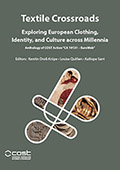Center, Textile Research

Textile Crossroads: Exploring European Clothing, Identity, and Culture across Millennia
Date of this Version
2024
Document Type
Article
Citation
In Textile Crossroads: Exploring European Clothing, Identity, and Culture across Millennia. Anthology of COST Action “CA 19131 – EuroWeb”. Kerstin Droß-Krüpe, Louise Quillien, & Kalliope Sarri, Editors. Zea Books, Lincoln, Nebraska, 2024. DOI: 10.32873/unl.dc.zea.1808
Abstract
Various kinds of textiles were used to furnish domestic spaces in Antiquity, such as curtains, covers, hangings, pillows, cushions, mattresses, rugs, tapestries, tablecloths, and towels. These objects have practical and everyday functions, they embellish and add to daily comfort in the house and speak to the owner’s prosperity. Being made of perishable materials, furnishings have, on the whole, not survived in ancient Mesopotamia, Greece, and Rome. Apart from a few excavated pieces of textiles found in tombs, our information comes primarily from written testimonia and iconography.
It is thus essential to consider soft furnishings in their own right, in order to better identify their vocabulary in the literary sources. In the private context, furnishings offer glimpses of the domestic life rarely documented in texts. In the religious context, furnishings provide clues for the interior sacred space, the cultic furniture, the various ceremonies that took place (opening and closing the curtains in front of the divine statue, arranging dishes on a nape, washing, and wiping hands during ablution rituals, etc.), and their luxurious production. Furthermore, the terminology of soft furnishings gives information about their material appearance, method of manufacture, and decoration, and should therefore be fully included in the economic and technical history of textile crafts in antiquity.
This article examines the terminologies of soft furnishings in three contexts: Babylonia in the 1st millennium BC, ancient Greece (5th–1st centuries BC) and the Roman world (3rd BC–3rd centuries AD). The observation of the vocabulary of soft furnishings in three different contexts and periods of the ancient world reveals common points, evolutions, circulation of objects, and uses.
Included in
Ancient History, Greek and Roman through Late Antiquity Commons, Archaeological Anthropology Commons, Classical Archaeology and Art History Commons, Classical Literature and Philology Commons, Eastern European Studies Commons, European History Commons, European Languages and Societies Commons, Fiber, Textile, and Weaving Arts Commons, History of Science, Technology, and Medicine Commons, Human Geography Commons, Museum Studies Commons, Place and Environment Commons, Social and Cultural Anthropology Commons, Women's Studies Commons


Comments
Copyright © 2024 by the authors.